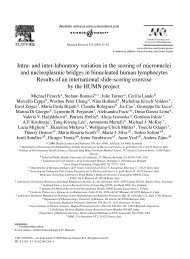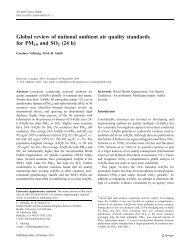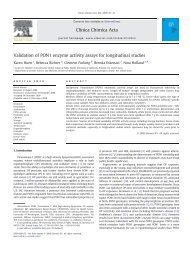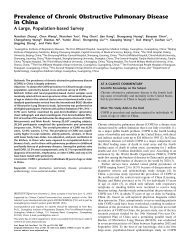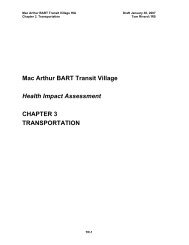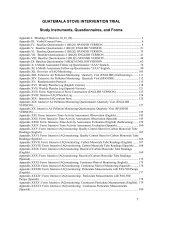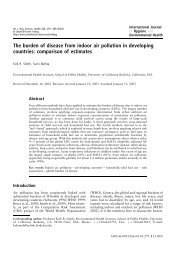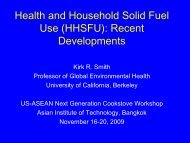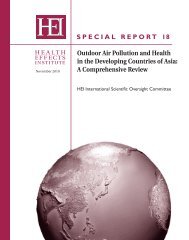Climate Change Decision Making: The Co-benefits Story
Climate Change Decision Making: The Co-benefits Story
Climate Change Decision Making: The Co-benefits Story
Create successful ePaper yourself
Turn your PDF publications into a flip-book with our unique Google optimized e-Paper software.
<strong>Climate</strong> <strong>Change</strong> <strong>Decision</strong> <strong>Making</strong>:<strong>The</strong> <strong>Co</strong>-<strong>benefits</strong> <strong>Story</strong>Kirk R. SmithProfessor of Global Environmental HealthUniversity of California, BerkeleyInternational <strong>Co</strong>lloquium on<strong>The</strong> Grand Scientific Challenges of<strong>Co</strong>mbating <strong>Climate</strong> <strong>Change</strong>Unversidad Autotnoma MetropolitanaMexico City, November 9, 2011
Cartogram of <strong>Climate</strong>-related Mortality (per million pop) yr. 2000PatzJA, Gibbs HK, Foley JA, Rogers JV, Smith KR, 2007, <strong>Climate</strong> change and global:Quantifying a growing ethical crisis EcoHealth 4(4): 397–405, 2007.
Cumulative CO 2 emissions from fossil fuels(as depleted by natural processes)Patz JA, Gibbs HK, Foley JA, Rogers JV, Smith KR, 2007, <strong>Climate</strong> change and global:Quantifying a growing ethical crisis EcoHealth 4(4): 397–405, 2007
Distribution of Health Impacts from<strong>Climate</strong> <strong>Change</strong>(Experiencing versus Imposing)10.00DALYs per 10001.000.100.010 5000 10000 15000 20000 25000 30000 350000.00PPP per capitaSmith and Rodgers
Ratio1000010001001010.10.01Distribution of Health Impacts from<strong>Climate</strong> <strong>Change</strong>(Ratio: Imposing/Experiencing)>8000x different!!0 5000 10000 15000 20000 25000 30000 35000Poor countries receive >16 times more healthrisk than they imposePPP per capitaRichcountriesimpose>500times morerisk thantheyreceive
CC Health Effects, cont.5) <strong>Co</strong>-<strong>benefits</strong>: Achieving health- andclimate-protection <strong>benefits</strong> with the samepolicies and projects
Proposed IPCC Definition of <strong>Co</strong>-Benefits• <strong>Co</strong>-benefit actions are those taken to mitigateclimate change that have significant <strong>benefits</strong> ofother types for society.• Although there is no mitigation action that does nothave at least some influence on other sectors, co<strong>benefits</strong>activities are those in which there issufficient impact to be considered an intervention intheir own right for those sectors.
Being Smart about Mitigation• <strong>Co</strong>-<strong>benefits</strong>: Guide mitigation measures sothey help achieve other societal goals,including health protection.• No-regrets: providing a short-term morecertain return (health) on a long-term moreuncertain investment (climate protection)• Win-win: Double return on single investment
Why Worry about <strong>Co</strong>-<strong>benefits</strong>?• Helps reduce the cost of mitigation by sharingcost with other sectors.• Recognizes that society still has major goalsbesides avoiding climate change, such asproviding acceptable levels of health protection• Potentially bridge political gap betweendeveloped and developing countries ininternational climate negotiations – earlyachievement of more certain <strong>benefits</strong> that directlyrelate to development needs
Global warming in 2005 due to all human emissions since 1750IPCC, 2007CO2 is themost importantGreenhouse GasMostly from fuelcombustion
Air Pollution from Energy Use• Outdoor emissions from energy systems• 1 million premature deaths around the world• Most well documented <strong>benefits</strong>, climate and health• Energy efficiency, fuel shifting lead to lessclimate impact and less ill-health• Some difficult issues related to relativeclimate impacts of different aerosols, e.g.,black carbon, sulfates, organic carbon
Cities<strong>Climate</strong> Warming in 2020 Under Present TrendsProceedings of the NationalAcademy of Sciences, 2010
Modifying the Built Environment• Obesity, traffic accidents, and lack ofphysical activity responsible for 3+ millionadditional premature deaths annually• Reduce vehicle use (air pollution, obesity,safety, etc)• <strong>Change</strong> urban design to increase physicalactivity (obesity, air pollution, safety)• Improve energy efficiency of buildings(avoid health risks of energy poverty)
Meatanddiary<strong>Climate</strong> Warming in 2020 Under Present TrendsUnger et al. PNAS 2010
Redirecting Diet Preferences• Livestock responsible for 20+% of globalgreenhouse emissions – methane from animaldigestion plus operation of meat/dairy feed/supplysystems• <strong>Co</strong>nverge on lower mean global red meatconsumption with health <strong>benefits</strong> in rich countriesin heart disease, diabetes, and colon cancer• Similar <strong>benefits</strong> to convergence in global dairyconsumption• China/India have the major global growthpotential
Trends in consumption of livestock products per personFAO
Global warming in 2005 due to all human emissions since 1750IPCC, 2007Methane is secondmost importantGreenhouse Gas
Methane<strong>Climate</strong> Warming in 2020 Under Present TrendsUnger et al. PNAS 2010
Methane Reduction• Second most important greenhouse gas• Major cause of rise in global troposphericozone concentrations – important healthdamagingand crop-damaging pollutant• Livestock a major source• Leaks: <strong>Co</strong>al mines, gas pipelines, etc.• Waste management: Landfills, wastewater• Incomplete combustion: biomass and coal
Mortality from ozone per 1000 km2 and per million peopleAnnenberg et al., 2010
Methane• Way to reduce warming in the next generation is toput more attention on methane (and other shorterlived GHGs)• <strong>The</strong> rate of warming is as important as the totalamount• Way to slow the rate is to immediately reducemethane emissions• Need to start working soon to lower rate in order togive us time to deal with CO2, a more difficultissue
Householdcookingwithbiomass<strong>Climate</strong> Warming in 2020 Under Present TrendsUnger et al. PNAS 2010
300-400 thousand years ago, hearths becamea regular feature in human habitation”On the earliest evidence forhabitual use of fire”Roebroeks and Villa,PNAS, 2011
800070006000500040003000200010000World Population Using Solid FuelsWorld PopSolid Fuel Users1965197019751980198519901995200020052010195019551960Million Peope
~30millionHouseholds Using Solid Fuels
Global warming in 2005 due to all human emissions since 1750IPCC, 2007CO 2 is important for climate,but so are many otherpollutants, including the onescircled that, unlike CO 2 , alsohave significant health aswell as climate impacts.All these are produced byincomplete combustionin household stoves usingsimple solid fuels
Household Fuels: where the mostrubber hits the co-<strong>benefits</strong> road• Large source of ill-health worldwide inpoorest populations ~ 2 million prematuredeaths annually• Non-renewable biomass and coal fuelsproduce net CO2 emissions• Poor combustion leads to non-CO2greenhouse-related emissions
Household Fuels a Major SourceCross‐checking of Outdoor results: Air Pollution in Asia%PM 2.5 from “Residential” Emissions from INTEX_B30%0%53%Householdof all PM2.5EmissionsChafe, 2010Source: Asian Emission Inventory for NASA INTEX_B 2006 (accessed 2010)30
Household combustion only a cause ofoutdoor air pollution in Asia?• Small particles, PM2.5, are the most important forhealth• According to the World Health Organization,Mexican cities have PM2.5 levels averaging 25‐30ug/m3 ‐‐ worst at 50 (Mex standard – 15)• Villages in Michoacán, just for comparison, have24‐h outdoor levels of 60‐90 ug/m3 (Zuk et al., 2006)• Nearly all from household combustion
ALRI/PneumoniaLow birthweightAsthma?Birth defects<strong>Co</strong>gnitiveImpairmentDiseases for which we haveepidemiological studies showinga link to household biomass useAlso burns and scaldsChronicobstructivelung diseaseCataractsLung cancer(cervical,aero-digestive?)Heart disease/strokeTuberculosis
Global Burden of Disease from Top 10 Risk Factorsplus selected other risk factorsPercent of All DALYs0.0% 2.0% 4.0% 6.0% 8.0% 10.0%UnderweightUnsafe sexBlood pressureTobaccoAlcoholUnsafe water/sanitationChild cluster vaccination*CholesterolLack of Malaria control*Indoor smoke from solid fuels1.6 million prematuredeaths/yearOverweightOccupational hazards (5 kinds)Road traffic accidents*Physical inactivityLead (Pb) pollutionUrban outdoor air pollution<strong>Climate</strong> changeChernobyl per month0.8 million prematuredeaths/year0.12 million prematuredeaths/year
To be published Nov 11, 2011
RESPIRE – Randomized trial (n=518)Impact on pneumonia up to 18 months of ageTraditional open 3-stone 3fire:kitchen 48-hour PM 2.5 levels of600 - 1200 μg/m3Chimney wood stove, locally madeand popular with households
CO monitorCO monitor
MD-diagnosed Acute Lower Respiratory InfectionWhere weWant toBe!ALRI Rate (per 100 Child-Yr)20 30 40 60 80(A)0 1 2 3 4 5 6 7Approximate Mean CO PM2.5 Exposure exposure (ppm) in 100s of ug/m3RESPIRE-Guatemala
Environmental Health PerspectivesNov, 2011
October2011
Cervical Cancer and Household Air PollutionThree papers; two done in Honduras, one in <strong>Co</strong>lumbia
What Intervention Affectsall of these Sectors<strong>Climate</strong> Warmingand has Majorin 2020HealthUnderBenefitsPresent Trendsas well?Unger et al. PNAS 2010
Most cost-effective GHG controldevice is probably a condom• Many tens of millions of women wish tohave fewer children, but do not have accessto contraceptives• Giving them access could mean ~2 billionfewer people by 2100 – a major reduction ofstress on the Earth• Many health <strong>benefits</strong>, particularly child andmaternal mortality, to smaller, more plannedfamilies
Risk ofMaternalMortality<strong>The</strong> very age groups thatmost wish to avoidpregnancy <strong>Co</strong>ntraceptive are thoseusewith the and highest Maternal riskMortalityof complications13 45Age of Mother
Child Deaths Potentially Averted
Proceedings of the National Academy of SciencesOctober 12, 2010 | vol. 107 | no. 41 | 17521–17526
Global CO2 Emissions Under different Fertility ScenariosO'Neill B C et al. PNAS 2010;107:17521-17526
Access to Reproductive Services• Not population control, but reproductiverights• All countries on the way to replacementfertility this century• Just a matter of making it possible to happensooner rather than later in the century• Large health <strong>benefits</strong> can be accrued
CO2 and methane onlyHaigler andSmith, 2008Smith and Haigler, Ann Rev of Public Health, 2008
Summary• Carbon dioxide controls absolutely needed toblunt climate change impacts• <strong>Co</strong>nsiderable health co-<strong>benefits</strong> in doing so ifprojects are targeted• Even greater health co-<strong>benefits</strong> can achieved byfocusing on other climate-altering pollutants(CAPs: methane, black carbon, etc.)• <strong>The</strong>se mostly have an impact on rate of warming,not total• But rate is also important for impacts
GraciasPublications andpresentations on website– easiest to just“google” Kirk R. Smith
Global warming in 2005 due to all human emissions since 1750IPCC, 2007Sulfate is coolingfor climate,but damaging tohealth



